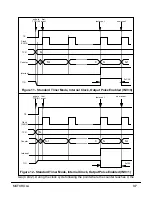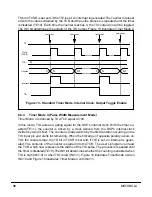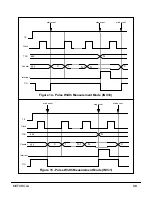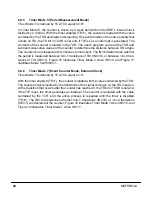
26
MOTOROLA
1. Send command WRITE PDB REGISTER and GO (no EX).
(ODEC selects PDB as destination for serial data.)
2. ACK
3. Send the 32-bit opcode: “ORI #$10, OMR”
(After the 32 bits have been received, the PDB register drives the PDB. ODEC releases the chip
from “halt” state and the ORI instruction is executed. This instruction sets the “CE” bit in the
OMR register. The signal that marks the end of the instruction returns the chip to the “halt” state
and an acknowledge is issued to the command controller.)
4. ACK
Only now can we read the valid-bits using the HIT/MISS mechanism as described in sec-
tion 5.2.
To switch back to the PRAM mode, the same sequence is preformed, but this time using
“ANDI #$ef, OMR”.
5.4.4
Synchronous Start of the Execution of Multiple Chips
This routine will load each processor with the information necessary for starting the exe-
cution of its program and in the end will synchronously release all the processors from the
Debug Mode.
1. The command controller selects the first processor.
2. Send command WRITE PDB REGISTER (no GO, no EX).
(ODEC selects PDB as destination for serial data.)
3. ACK
4. Send 32 bits of the opcode of a two word jump instruction ($030c3f80).
(After all the 32-bits have been received the PDB register drives the PDB. ODEC causes the
core to load the opcode. An acknowledge is issued to the command controller.)
5. ACK
6. Send command WRITE PDB REGISTER (no GO, no EX).
(ODEC selects PDB as destination for serial data.)
7. ACK
8. Send 32 bits of the target absolute address for the first processor ($xxxxxxxx)
9. ACK
10. The command controller selects the second processor.
11. Send command WRITE PDB REGISTER (no GO, no EX).
(ODEC selects PDB as destination for serial data.)
12. ACK
13. Send 32 bits of the opcode of a two word jump instruction ($030c3f80).
(After all the 32-bits have been received the PDB register drives the PDB. ODEC causes the
core to load the opcode. An acknowledge is issued to the command controller.)
14. ACK
Summary of Contents for DSP96002
Page 3: ...1 2 DSP96002 USER S MANUAL MOTOROLA ...
Page 38: ...MOTOROLA DSP96002 USER S MANUAL 3 15 Figure 3 4 Modulo Arithmetic Unit Block Diagram ...
Page 39: ...3 16 DSP96002 USER S MANUAL MOTOROLA ...
Page 53: ...4 14 DSP96002 USER S MANUAL MOTOROLA ...
Page 76: ...MOTOROLA DSP96002 USER S MANUAL 5 23 Figure 5 8 Address Modifier Summary ...
Page 86: ...6 10 DSP96002 USER S MANUAL MOTOROLA ...
Page 101: ...MOTOROLA DSP96002 USER S MANUAL 7 15 Figure 7 9 HI Block Diagram One Port ...
Page 140: ...7 54 DSP96002 USER S MANUAL MOTOROLA ...
Page 166: ...9 10 DSP96002 USER S MANUAL MOTOROLA ...
Page 181: ...MOTOROLA DSP96002 USER S MANUAL 10 15 Figure 10 8 Program Address Bus FIFO ...
Page 337: ...MOTOROLA DSP96002 USER S MANUAL A 149 ...
Page 404: ...A 216 DSP96002 USER S MANUAL MOTOROLA PC xxxx D ...
Page 460: ...A 272 DSP96002 USER S MANUAL MOTOROLA SIOP Not affected ...
Page 484: ...A 296 DSP96002 USER S MANUAL MOTOROLA SSH PC SSL SR SP 1 SP ...
Page 519: ...MOTOROLA DSP96002 USER S MANUAL A 331 ...
Page 718: ...MOTOROLA DSP96002 USER S MANUAL B 199 ...
Page 871: ... MOTOROLA INC 1994 MOTOROLA TECHNICAL DATA SEMICONDUCTOR M Addendum ...
Page 888: ...MOTOROLA INDEX 1 INDEX ...
Page 889: ......
















































